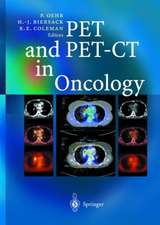System Engineering Approach to Planning Anticancer Therapies
Autor Andrzej Świerniak, Marek Kimmel, Jaroslaw Smieja, Krzysztof Puszynski, Krzysztof Psiuk-Maksymowiczen Limba Engleză Hardback – 27 mai 2016
The book begins with an analysis of cell cycle control, moving on to control effects on cell population and structured models and finally the signaling pathways involved in carcinogenesis and their influence on therapy outcome. It also discusses the incorporation of intracellular processes using signaling pathway models, since the successful treatment of cancer based on analysis of intracellular processes, might soon be a reality. It brings together various aspects of modeling anticancer therapies, which until now have been distributed over a wide range of literature. Written for researchers and graduate students interested in the use of mathematical and engineering tools in biomedicine with special emphasis on applications in cancer diagnosis and treatment, this self-contained book can be easily understood with only a minimal basic knowledge of control and system engineering methods as well as the biology of cancer. Its interdisciplinary character and the authors’ extensive experience in cooperating with clinicians and biologists make it interesting reading for researchers from control and system engineering looking for applications of their knowledge. Systems and molecular biologists as well as clinicians will also find new inspiration for their research.
| Toate formatele și edițiile | Preț | Express |
|---|---|---|
| Paperback (1) | 385.47 lei 6-8 săpt. | |
| Springer International Publishing – 26 mai 2018 | 385.47 lei 6-8 săpt. | |
| Hardback (1) | 392.75 lei 6-8 săpt. | |
| Springer International Publishing – 27 mai 2016 | 392.75 lei 6-8 săpt. |
Preț: 392.75 lei
Nou
Puncte Express: 589
Preț estimativ în valută:
75.15€ • 78.68$ • 62.18£
75.15€ • 78.68$ • 62.18£
Carte tipărită la comandă
Livrare economică 05-19 aprilie
Preluare comenzi: 021 569.72.76
Specificații
ISBN-13: 9783319280936
ISBN-10: 3319280937
Pagini: 222
Ilustrații: IX, 235 p. 55 illus., 17 illus. in color.
Dimensiuni: 155 x 235 x 16 mm
Greutate: 0.53 kg
Ediția:1st ed. 2016
Editura: Springer International Publishing
Colecția Springer
Locul publicării:Cham, Switzerland
ISBN-10: 3319280937
Pagini: 222
Ilustrații: IX, 235 p. 55 illus., 17 illus. in color.
Dimensiuni: 155 x 235 x 16 mm
Greutate: 0.53 kg
Ediția:1st ed. 2016
Editura: Springer International Publishing
Colecția Springer
Locul publicării:Cham, Switzerland
Public țintă
ResearchCuprins
Introduction.- Cell Cycle as an Object of Control.- Therapy Optimization in Population Dynamics Models.- Structured Models and Their Use in Modeling Anticancer Therapies.- Signaling Pathways Dynamics and Cancer Treatment.- Model Identification and Parameter Estimation.- Appendixes: Stability and Controllability of Dynamical Systems.- Pontryagin Maximum Principle and Optimal Control.- Bifurcation Analysis.- Numerical Implementation of the Runge Kutta and Gillespie Methods.
Notă biografică
Andrzej Swierniak received his PhD in Automatic Control from the Silesian University of Technology, Gliwice Poland. He published approximately 300 papers. He is a Fellow of the American Mathematical Society, and a member of the IEEE, Society of Mathematical Biology, Polish Society of Theoretical and Applied Electrotechnics, IFAC Committees 1.4 and 8.2, Committees of Automatic Control and Robotics, and Biocybernetics and Biomedical Engineering of Polish Academy of Science. He is an editorial boards member of Mathematical Bioscience, International Journal of Applied Mathematics and Computer Science, Mathematical Problems in Engineering, and the Editor in Chief of Archives of Control Sciences. His current interests are in control and optimization, biomathematical modeling and systems biology. His research has been supported by Polish National Centre Science, Polish National Centre of Research and Development, NATO, and European Community FP6 and FP7. Dr Swierniak has advised 10PhD and 50 MS students and has organized numerous conferences and international meetings in System Engineering and Systems Biology.
Marek Kimmel is a Professor of Statistics and Bioengineering at the Rice University in Houston, TX, USA and a Professor in the Systems Engineering Group in the Silesian University of Technology in Gliwice, Poland. He is an author and co-author of over 200 peer-reviewed publications and 5 monographs. His professional interests are focused in application of stochastic processes in molecular and cell biology and genetics. He advised about 30 doctoral students in USA, Poland and France. His research has been supported by grants from NSF, NIH, NATO, ERC, NCN (Polish National Science Committee), EPSRC (UK). He is the Mathematical Biology Editor of Biology Direct and in 2011 was the Fellow at the Institute for Advanced Study at Warwick University, UK. He is a Fellow of the American Statistical Association.
Jaroslaw Smieja received PhD degree in Automatic Control from the Silesian University of Technology, Gliwice Poland, in 2000. His research interests include systems application of mathematical modeling and control theory methods to analysis of biological systems both at intracellular and cell population levels. In particular, he is involved in development of signaling pathway models, describing cell responses to stress factors and viral infections as well as optimization of anticancer treatment protocols. He is an author and co-author of over 80 peer-reviewed publications. He reviews paper for many international journals, including Journal of Theoretical Biology, Mathematical Biosciences and Mathematical Biosciences and Engineering. Dr Smieja teaches numerous courses at the Silesian University of Technology, including Systems Dynamics, Optimization Methods, Bioinformatics and Mathematical Modeling in Biology and Medicine.
Krzysztof Psiuk-Maksymowicz obtained his PhD degree in Biocybernetics and MedicalEngineering from Silesian University of Technology, Gliwice Poland, in 2009. He works as an assistant professor at Institute of Automatic Control of Silesian University of Technology. In 2004-2007 he worked as a young research scientist in the Department of Physics, Gothenburg University, Sweden. His research focuses on mathematical biology, in particular modeling of tumor growth and therapeutic actions, as well as medical image processing. He has published over 30 papers in journals and refereed conference proceedings. He took part in many national and international projects, focused on either basic research, applications or software development.
Krzysztof Puszynski received his M. Sc degree in automatic control and robotics from Silesian University of Technology in 2003 and Ph.D. in biocybernetics and biomedical engineering also from Silesian University of Technology in 2009. His main research interests include systems biology, bioinformatics and control engineering in biological systems. He was a visiting professor in the Institute of the Systems Analysis and Informatics in Rome in 2011 and University of Alberta in Edmonton, Canada in 2012. He is presently an Assistant Professor in the Department of Automatic Control at the Silesian University of Technology. He is an author or co-author of more than 50 journal articles, book chapters and conference papers.
Marek Kimmel is a Professor of Statistics and Bioengineering at the Rice University in Houston, TX, USA and a Professor in the Systems Engineering Group in the Silesian University of Technology in Gliwice, Poland. He is an author and co-author of over 200 peer-reviewed publications and 5 monographs. His professional interests are focused in application of stochastic processes in molecular and cell biology and genetics. He advised about 30 doctoral students in USA, Poland and France. His research has been supported by grants from NSF, NIH, NATO, ERC, NCN (Polish National Science Committee), EPSRC (UK). He is the Mathematical Biology Editor of Biology Direct and in 2011 was the Fellow at the Institute for Advanced Study at Warwick University, UK. He is a Fellow of the American Statistical Association.
Jaroslaw Smieja received PhD degree in Automatic Control from the Silesian University of Technology, Gliwice Poland, in 2000. His research interests include systems application of mathematical modeling and control theory methods to analysis of biological systems both at intracellular and cell population levels. In particular, he is involved in development of signaling pathway models, describing cell responses to stress factors and viral infections as well as optimization of anticancer treatment protocols. He is an author and co-author of over 80 peer-reviewed publications. He reviews paper for many international journals, including Journal of Theoretical Biology, Mathematical Biosciences and Mathematical Biosciences and Engineering. Dr Smieja teaches numerous courses at the Silesian University of Technology, including Systems Dynamics, Optimization Methods, Bioinformatics and Mathematical Modeling in Biology and Medicine.
Krzysztof Psiuk-Maksymowicz obtained his PhD degree in Biocybernetics and MedicalEngineering from Silesian University of Technology, Gliwice Poland, in 2009. He works as an assistant professor at Institute of Automatic Control of Silesian University of Technology. In 2004-2007 he worked as a young research scientist in the Department of Physics, Gothenburg University, Sweden. His research focuses on mathematical biology, in particular modeling of tumor growth and therapeutic actions, as well as medical image processing. He has published over 30 papers in journals and refereed conference proceedings. He took part in many national and international projects, focused on either basic research, applications or software development.
Krzysztof Puszynski received his M. Sc degree in automatic control and robotics from Silesian University of Technology in 2003 and Ph.D. in biocybernetics and biomedical engineering also from Silesian University of Technology in 2009. His main research interests include systems biology, bioinformatics and control engineering in biological systems. He was a visiting professor in the Institute of the Systems Analysis and Informatics in Rome in 2011 and University of Alberta in Edmonton, Canada in 2012. He is presently an Assistant Professor in the Department of Automatic Control at the Silesian University of Technology. He is an author or co-author of more than 50 journal articles, book chapters and conference papers.
Textul de pe ultima copertă
This book focuses on the analysis of cancer dynamics and the mathematically based synthesis of anticancer therapy. It summarizes the current state-of-the-art in this field and clarifies common misconceptions about mathematical modeling in cancer. Additionally, it encourages closer cooperation between engineers, physicians and mathematicians by showing the clear benefits of this without stating unrealistic goals. Development of therapy protocols is realized from an engineering point of view, such as the search for a solution to a specific control-optimization problem. Since in the case of cancer patients, consecutive measurements providing information about the current state of the disease are not available, the control laws are derived for an open loop structure. Different forms of therapy are incorporated into the models, from chemotherapy and antiangiogenic therapy to immunotherapy and gene therapy, but the class of models introduced is broad enough to incorporate other forms of therapy as well.
The book begins with an analysis of cell cycle control, moving on to control effects on cell population and structured models and finally the signaling pathways involved in carcinogenesis and their influence on therapy outcome. It also discusses the incorporation of intracellular processes using signaling pathway models, since the successful treatment of cancer based on analysis of intracellular processes, might soon be a reality. It brings together various aspects of modeling anticancer therapies, which until now have been distributed over a wide range of literature. Written for researchers and graduate students interested in the use of mathematical and engineering tools in biomedicine with special emphasis on applications in cancer diagnosis and treatment, this self-contained book can be easily understood with only a minimal basic knowledge of control and system engineering methods as well as the biology of cancer. Its interdisciplinary character and the authors’ extensive experience in cooperating with clinicians and biologists make it interesting reading for researchers from control and system engineering looking for applications of their knowledge. Systems and molecular biologists as well as clinicians will also find new inspiration for their research.
Caracteristici
Provides an overview about mathematical modeling in cancer Focuses on the analysis of cancer dynamics Brings together various aspects of modeling anticancer therapies














